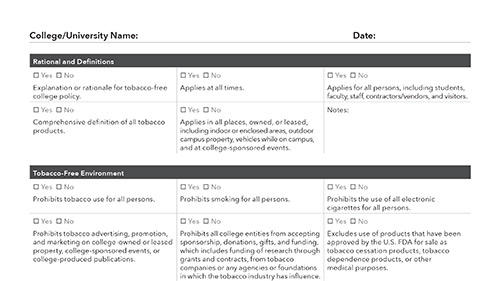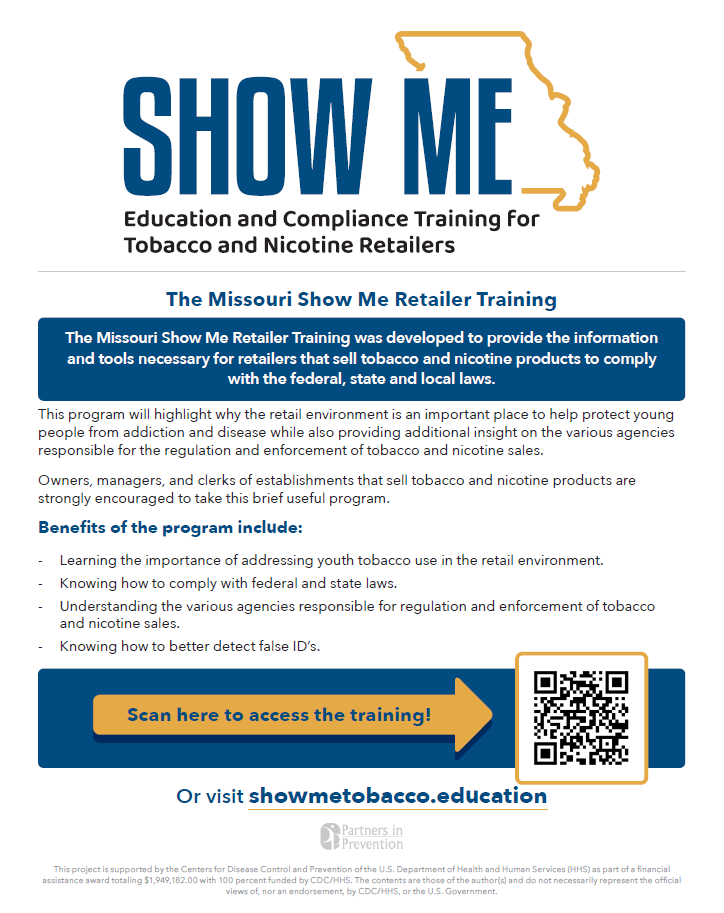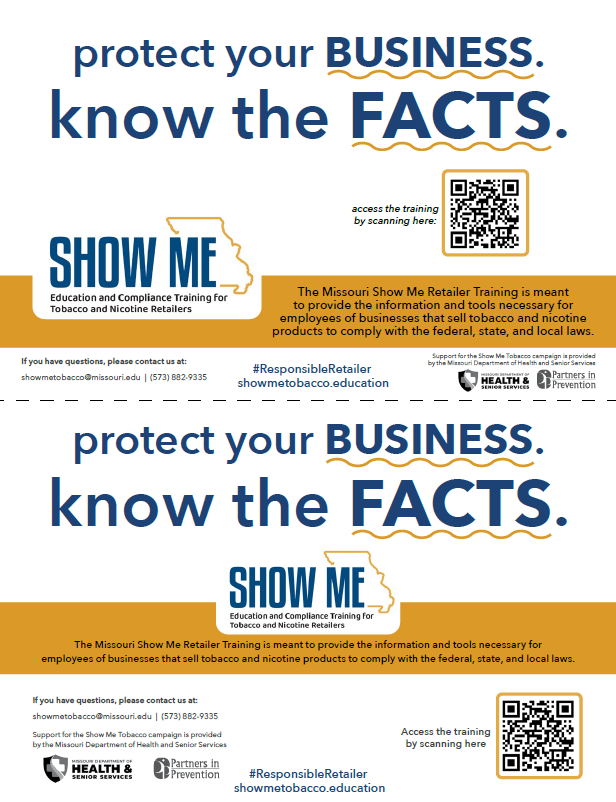
Missouri Partners in Prevention (PIP) has several resources available to assist campuses with their tobacco prevention and control efforts.
PIP has been funded by the Department of Health and Senior Services and the Department of Mental Health to address tobacco use among young people using a variety of evidence-based strategies such as the promotion to quit services and updating tobacco free campus policies. This includes toolkits, media playbooks and even sample tobacco free campus policy language. To learn more about these resources or to get in touch with our PIP staff member, please feel free to email Brittany Carpenter at bcndf@missouri.edu.
Scope
National Data
Tobacco kills more than 7 million people each year, including an estimated 1.6 million non-smokers who are exposed to second-hand smoke.1
In 2023, 9.4% of people aged 12 or older vaped nicotine in the past month, up from 8.3% in 2022.2 In the past year, more people-initiated vaping (5.9 million people) compared to any other substance.
A survey from the fall of 2024, found that the most used tobacco products among college students (76%) in the United States were e-cigarettes or other vape products.3
Below are the rates for other forms of tobacco use in 2023:
- Any tobacco use: 16.8%
- Cigar smoking: 1.0%
- Pipe smoking: 0.1%
- Smokeless tobacco: 0.3%
Missouri Data
Among Missouri college students, past year use of any tobacco/nicotine products has increased from 23% in 2023 to 28% in 2025, matching rates in 2020.
The most commonly used tobacco/nicotine product are e-cigarettes at 21%, followed by cigarettes (12%), smokeless tobacco (7.0%), cigars (4.7%) and hookah (1.4%)
Smokeless tobacco products have been increasing in popularity, rising from 2.4% in 2022 to 7.0% in 2025.
71% of students have reported being exposed to secondhand smoke/vapor. They are exposed to secondhand smoke/vapor at the following locations:
| Off-campus social gathering | Bar or restaurant | Outdoor public space | In a friend’s car | In one’s own living space | In someone else’s living space | In a college campus building | In one’s own car |
| 67% | 54% | 50% | 39% | 25% | 23% | 19% | 17% |
72% of students have indicated that they have wanted to quit or have quit tobacco/ nicotine since entering college.
When citing reasons for quitting use, students have said:
- They don’t want to have a habit they will regret (e.g. being dependent on tobacco/nicotine): 52%
- The potential of getting sick or developing a lasting disease: 45%
- Tobacco products cost too much: 34%
Tobacco/Nicotine Products
Many of us think of tobacco products as traditional cigarettes and other nicotine products that have long been on the market in the United States. While those products are still on the market and used by many Americans, new and novel products continue to pose a threat to public health and all the progress we have made regarding use rates over the last several years. We think it is important to highlight some of the newer products and educate our community on why it is still important to address tobacco use.
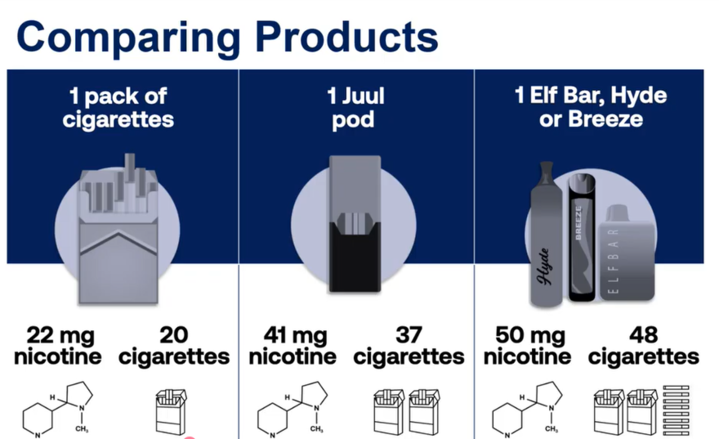
Nicotine Pouches
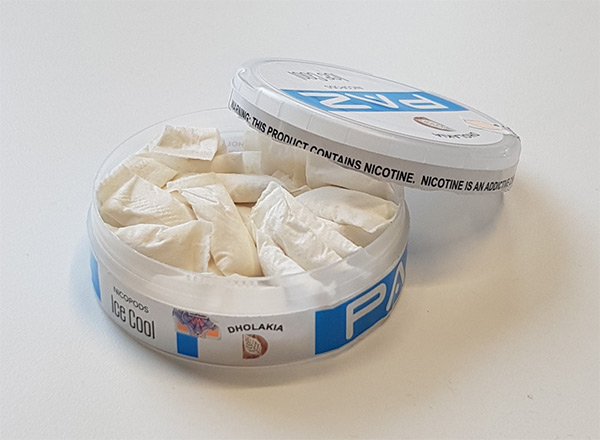
Nicotine pouches contain a powder made of nicotine, flavorings, and other ingredients. The powder dissolves in the mouth, and nicotine is absorbed through the gums and lining of the mouth. There is a lot of misinformation regarding this new products category, and we are seeing the industry target youth and young adults in the same way they have with other tobacco products in the past. For more information about these products, visit Nicotine Pouches | Smoking and Tobacco Use | CDC or Oral nicotine pouches from the Truth Initiative to learn more.
E-Cigarettes, Vapes, and Other Electronic Nicotine Delivery Systems
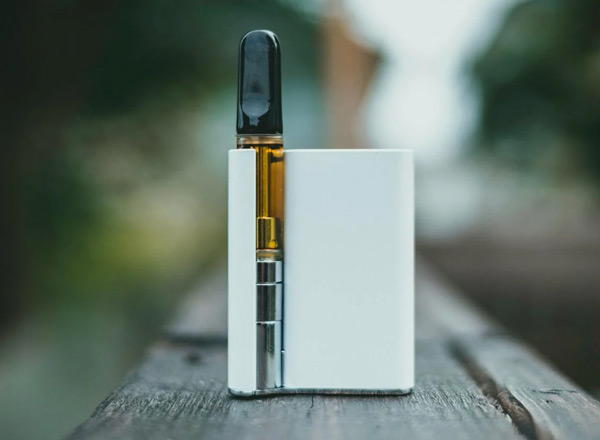
Vapes, vaporizers, vape pens, hookah pens, electronic cigarettes, e-cigars, and e-pipes are some of the many tobacco product terms used. These products use an “e-liquid” or pod-based system that usually contains nicotine derived from tobacco, as well as flavorings, propylene glycol, vegetable glycerin, and other ingredients. While we know more now about these products than when they first entered the market, there is still a lot that we do not know about the long-term health consequences of use.
To learn more about e-cigarettes, visit E-Cigarettes, Vapes, and other Electronic Nicotine Delivery Systems (ENDS) | FDA. The Truth Initiative and the American Heart Association also provide valuable information regarding these products.
Environmental Impacts
E-cigarettes and the Environment
There are several reasons why people might be interested in quitting, and the environment might be one of them. Most disposable vapes contain plastic, batteries, and electric parts. When thrown away, they usually end up in landfills, becoming electronic waste that is difficult to recycle. The huge environmental cost is something to be aware of as we continue to see the rise in use of disposable products. Here are a few resources that share more about the environmental impact of these products:
PIP Resources
Toolkits
Time to Change? | Partners in Prevention
- Time to Change is a helpful site if you’re a Missouri college student considering quitting tobacco/nicotine or marijuana/cannabis. This website can help you assess your use, learn about benefits you can expect from quitting, and find resources to help you quit. If you’re a campus prevention or health promotion professional in Missouri, this site can help you access training and resources to help students quit.
- For more information about this resource, visit Time to Change? | Partners in Prevention
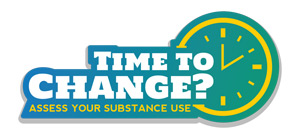
Show Me Tobacco Education and Compliance Training for Tobacco and Nicotine Retailers
- The Missouri Show Me Retailer Training was developed to provide the information and tools necessary for retailers that sell tobacco and nicotine products to comply with the federal, state, and local laws.
- This program will highlight why the retail environment is an important place to help protect young people from addiction and disease while also gaining additional insight into the various agencies responsible for the regulation and enforcement of the tobacco industry.
- Owners, managers, and clerks of establishments that sell tobacco and nicotine products are strongly encouraged to take this brief, useful program.
- For more information and resources to support retailer education, please visit Show Me Tobacco.
- If you are looking to order items to promote Show Me, please use this link to view available promotional items and resources: Missouri Show Me Retailer Training Item Request (cognito)
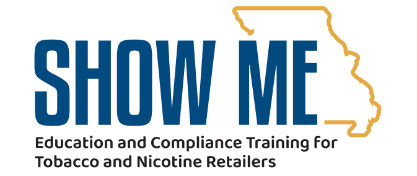
Educational Materials
PIP has developed brochures, bulletin boards, social media playbooks, a ‘Tobacco 101 Program to Go’ and other resources to assist campuses in educating students and preventing tobacco/nicotine use. Email our staff at pip@missouri.edu to access resources.
Engage with Tobacco/Nicotine Retailers
Looking to engage with local tobacco/nicotine retailers? These resources can help you engage with local businesses to encourage participation training to ensure they are aware of federal, state and local laws regarding sales of these products.
Show Me Tobacco Education and Compliance Training for Tobacco and Nicotine Retailers
If you are looking to order items to promote Show Me, please use this link to view available promotional items and resources: Missouri Show Me Retailer Training Item Request (cognito)
- The Missouri Show Me Retailer Training was developed to provide the information and tools necessary for retailers that sell tobacco and nicotine products to comply with the federal, state, and local laws.
- This program will highlight why the retail environment is an important place to help protect young people from addiction and disease while also gaining additional insight into the various agencies responsible for the regulation and enforcement of the tobacco industry.
- Owners, managers, and clerks of establishments that sell tobacco and nicotine products are strongly encouraged to take this brief, useful program.
- For more information and resources to support retailer education, please visit Show Me Tobacco.
- If you are looking to order items to promote Show Me, please use this link to view available promotional items and resources: Missouri Show Me Retailer Training Item Request (cognito)

Cessation Resources
Time to Change? | Partners in Prevention
- Time to Change is a helpful site if you’re a Missouri college student considering quitting tobacco/nicotine or marijuana/cannabis. This website can help you assess your use, learn about benefits you can expect from quitting, and find resources to help you quit. If you’re a campus prevention or health promotion professional in Missouri, this site can help you access training and resources to help students quit.
- For more information about this resource, visit Time to Change? | Partners in Prevention

Quit Programs
- Missouri Tobacco Quit Services: 1-800-QUIT-NOW
- My Life My Quit: Text START MY QUIT to 36072
- BecomeAnEX: Text QUIT to 202-804-9884
- This is Quitting: Text DITCHJUUL to 88709
Websites
- Become an Ex: becomeanex.org
- Freedom from Smoking: freedomfromsmoking.org
- HealthLine – How to Quit Vaping: healthline.com/health/how-to-quit-vaping#timing
- Missouri Tobacco Quit Services: youcanquit.org
- My Life My Quit: mylifemyquit.com
- SmokeFree: smokefree.gov
- The Truth Initiative: This is Quitting: truthinitiative.org/thisisquitting
- Very Well Mind – Tips for Going Out When You’re Trying Not to Smoke: verywellmind.com/going-out-after-quitting-smoking-4796606
Inclusion of a particular resource is not an official endorsement from Partners in Prevention or any of our funding sources.
Data Briefs
At a Glance
- 2025 MACHB At a Glance: Tobacco Use
- 2024 MACHB At a Glance: Substance Use
- 2021 MACHB Key Findings At a Glance: Substance Use
- 2020 MACHB At a Glance: E-Cigarette Use, Mental Health, and Well-being
- 2020 Students’ Well-being Survey Key Findings: Cannabis, Prescription Drugs, and Tobacco/Nicotine Use
- 2019 MACHB At a Glance: Tobacco and Nicotine Use
- 2019 MACHB At a Glance: Misperceptions of Substance Use
- 2019 MACHB At a Glance: Substance Misuse and GPA
Volume 14
- Volume 14, Number 5: Tobacco/Nicotine Use Among Missouri College Students
- Volume 14, Special Edition: Survey of Missouri Higher Education Institutions’ Tobacco-Free Policies
Volume 12
Volume 10
Volume 8
Volume 5
Volume 4
Volume 1
Missouri Higher Education Tobacco-Free Policies
In partnership with the Missouri Department of Health and Senior Services, PIP conducts annual reviews of tobacco-free policies from 62 higher education institutions in Missouri. Located below is information from the 2025 policy review conducted in July-August 2025.
Most institutions, n = 51, have a tobacco-free policy, and 11 do not. Of the 51 with policies, an assessment was conducted to determine the comprehensiveness of each institutions’ policies which were categorized by tiers 1-4. Tier 1 demonstrates model comprehensiveness:
- Tier 1: 5 institutions
- Tier 2: 16 institutions
- Tier 3: 13 institutions
- Tier 4: 17 institutions
Below are results from the 2025 policy assessment and demonstrates the percentage of the 51 policies that include an item versus not.
Rationale and Definitions
| Yes | No | |
| Explanation/rationale for tobacco-free college policy. | 67% | 33% |
| Applies at all times | 20% | 80% |
| Applies for all persons, including students, faculty, staff, contractors/vendors, and visitors. | 67% | 33% |
| Comprehensive definition of all tobacco products. | 67% | 33% |
| Applies in all places, owned, or leased, including indoor or enclosed areas, outdoor campus property, vehicles while on campus, and at college-sponsored events. | 63% | 37% |
Tobacco-Free Environment
| Yes | No | |
| Prohibits tobacco use for all persons. | 61% | 39% |
| Prohibits smoking for all persons. | 65% | 35% |
| Prohibits the use of all electronic cigarettes for all persons. | 67% | 33% |
| Prohibits tobacco advertising, promotion, and marketing on college-owned or leased property, college-sponsored events, or college-produced publications. | 25% | 75% |
| Prohibits all college entities from accepting sponsorships, donations, gifts, and funding, which includes funding of research through grants and contracts, from tobacco companies or any agencies or foundations in which the tobacco industry has influence. | 8% | 92% |
| Excludes use of products that have been approved by the U.Ss FDA for sale as tobacco cessation products, tobacco dependence products, or other medical purposes. | 20% | 80% |
| Excludes the use of traditional, sacred tobacco as part of an Indigenous practice or a lawfully recognized religious, spiritual, or cultural ceremony or practice. | 2% | 98% |
| Prohibits tobacco and related companies from participating in career fairs and recruitment activities. | 2% | 98% |
Cessation and Treatment Services
| Yes | No | |
| Offers and/or promotes cessation access for students. | 41% | 59% |
| Offers and/or promotes cessation access for staff. | 41% | 59% |
Enforcement
| Yes | No | |
| All individuals on college property are responsible for enforcing this policy and encouraged to communicate this policy with courtesy and diplomacy. | 47% | 53% |
| General enforcement – Students | 65% | 35% |
| General enforcement – Employees | 61% | 39% |
| General enforcement – Visitors/Vendor | 55% | 45% |
| Students who violate the policy will be referred to the appropriate campus contact for screening, information, counseling, and/or referral. | 35% | 65% |
| Consequences for violations – Employees | 45% | 55% |
| Consequences for violations – Visitors/Vendors | 35% | 65% |
| Designates those responsible for enforcement – Students | 43% | 57% |
| Designates those responsible for enforcement – Employees | 45% | 55% |
| Designates those responsible for enforcement – Visitors/Vendors | 35% | 65% |
| Employees who violate the policy will be offered cessation access information and/or referral. | 12% | 88% |
| Visitors/Vendors who violate the policy will be offered cessation access information and/or referral. | 10% | 90% |
Policy Communication
| Yes | No | |
| General policy communication | 14% | 86% |
| Signage about tobacco-free campus policy at all points of entry to the campus, at all building entrances, and other highly visible locations. | 16% | 84% |
| Notifies students of policy through student handbooks and orientations. | 6% | 94% |
| Provides policy in job postings, staff handbooks, orientations and employee trainings, and contracts with vendors or contractors. | 6% | 94% |
| Announcements about the policy and policy changes will be communicated through the college communication channels, such as publications and website. | 6% | 94% |
| Announcements of tobacco-free policy at events and throughout the events, when possible | 0% | 100% |
| Ashtrays are not provided on campus | 96% | 4% |
| Effective date | 63% | 37% |
| Designates individual, role, or office for questions or concerns about the policy. | 35% | 65% |
| Designates individual or office responsible for maintaining the policy at least annually. | 12% | 88% |
Partnerships and Collaborations
The work that we have been able to achieve in PIP and working with colleges and universities throughout the state has been in large part due to our collaboration and partnership with the following agencies:
- Missouri Department of Mental Health (DMH)
- Missouri Department of Health and Senior Services (DHSS)
- Eliminate Tobacco Use
These entities also provide several resources and information that are instrumental in achieving tobacco prevention and control initiatives.
Citations
- Smoking and tobacco. Institute for Health Metrics and Evaluation. (n.d.). https://www.healthdata.org/research-analysis/health-topics/smoking-and-tobacco
- Substance Abuse and Mental Health Services Administration. (2024). Key substance use and mental health indicators in the United States: Results from the 2023 National Survey on Drug Use and Health (HHS Publication No. PEP24-07-021, NSDUH Series H-59). Center for Behavioral Health Statistics and Quality, Substance Abuse and Mental Health Services Administration. https://www.samhsa.gov/data/report/2023-nsduh-annual-national-report
- Elflein, J. (2023, August 31). College students tobacco use by product U.S. 2020. Statista. https://www.statista.com/statistics/1126218/us-college-student-tobacco-use-by-product/
Previous Tobacco Policy Assessment Report
Hover over the yellow + to see 2024-25 data.
Rationale and Definitions











Cessation and Treatment Services





Policy Communication
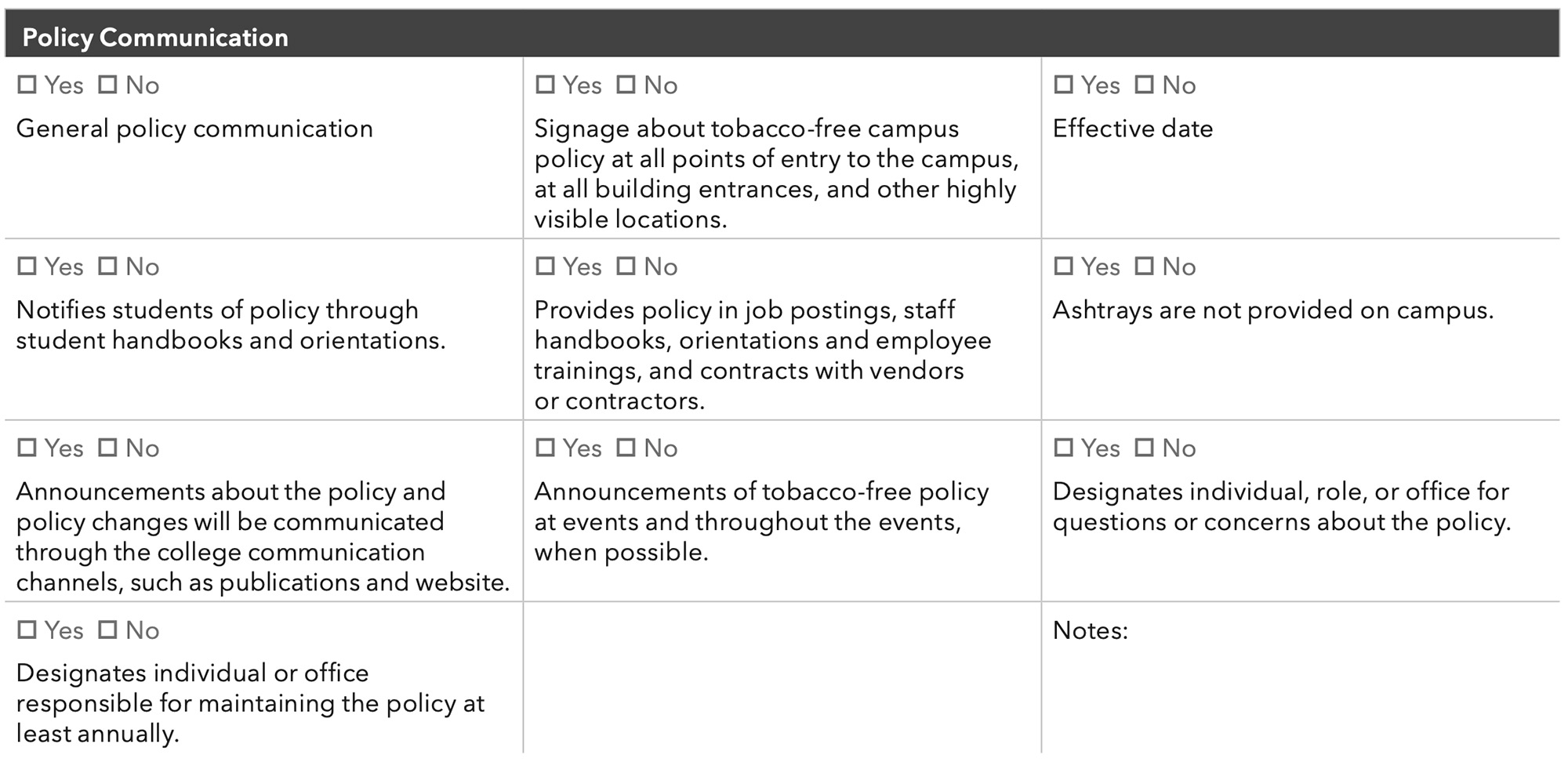








Tobacco-Free Environment
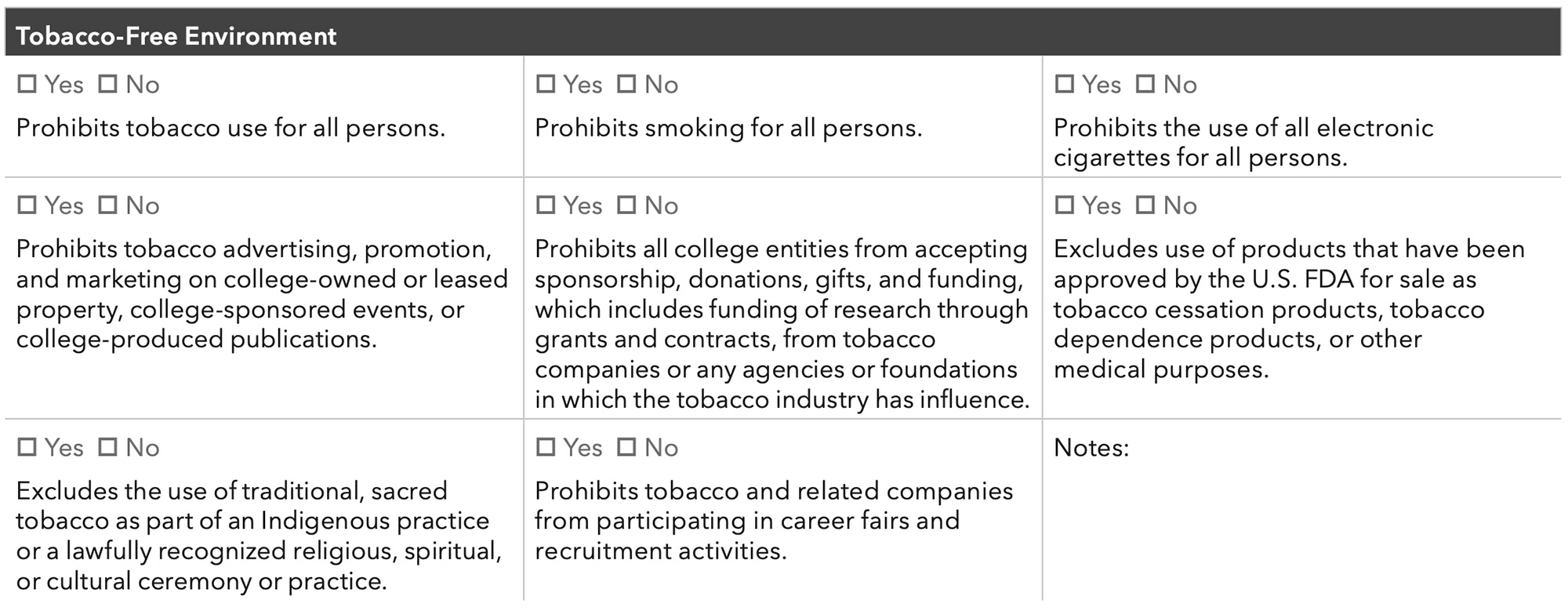
















Funding Statement
This project is supported by the Centers for Disease Control and Prevention of the U.S. Department of Health and Human Services (HHS) as part of a financial assistance award totaling $1,949,182.00 with 100 percent funded by CDC/HHS. The contents are those of the author(s) and do not necessarily represent the official views of, nor an endorsement, by CDC/HHS, or the U.S. Government.
